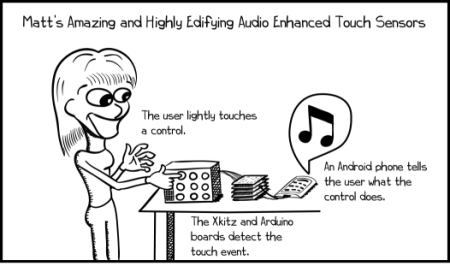
[Matt Oppenheim] wrote in to share his work with us. He has been modifying the interfaces of electronics for the visually impaired. It started off with cassette decks. As [Matt] points out, many people who are visually impaired use cassettes for their audio books and newspapers. [Matt] added some touch sensors to the buttons so that he could have something announce what each button was as the user felt them. This allowed them to quickly learn the layout of the device.
After finding that the simple interface on the cassette player was learned very quickly, thereby making his addition no longer needed, he decided to go after something a little more complex. [Matt] set out to modify a digital radio with many more buttons that are less touch friendly. As you can see in the video after the break, he was able to pull this off quite nicely.
The link above shows how he did it with his android phone in conjunction with an IOIO board. If you wanted to replicate this with an arduino, he has also published an entire build for you to follow.















From your friends at Menocu. Fabulous House of the Future!
http://www.funnyordie.com/videos/28344ab514/mr-show-house-of-the-future-from-mrshow_fan
Dumb ain’t funny!
While not visually impaired to where my eyesight can’t be corrected to 20/20, I entered the disability community 18 years ago and it’s great persons as Matt take an initiative to assist, but I do have questions, as it appears he has input from the visually impaired. Including the time it takes someone to modify a device, modify the code, is this appreciably faster method to learn the operation of new device? How comfortable are the visually impaired with voiding the warranty by internal modification of a device they may ill afford to replace? Is a smartphone with a touch screen input, and layers of menus a phone the visually impaired would choose for daily use given cost considerations?
Not this doesn’t have a direction to go. Develop a way to quickly create custom touch sensitive overlays to avoid internal modifications. Ditch the smart phone, along with the arduino and associated shields. Developed code and a custom board that will play mp3 files. No doubt the visually impaired community itself would be happy to create a vast library of mp3 files to share with others.
I wonder if a really tiny “RFID” sticker or chip, embedded within ‘nobs’ and buttons would work well. You have to have a glove with miniture RFID readers thoght. However I can imagine you can store really really short soundclips or text in the chip saying what each button does.
I built this to demonstrate the idea. There are some stereos produced by e.g. Roberts aimed at the visually impaired community with larger, tactile controls. However these are still a little difficult to use if you can’t clearly see the controls. Touch sensor technology is now cheap to implement and the existing audio hardware in the stereo could be used to produce the sound tags. I hope that this idea is taken up by manufacturers.
Nice build and noble cause!
My thoughts:
1. Interfacing the IOIO to the Android over Bluetooth may add a nice touch.
2. You already have a resistor on the IOIO for limiting the current. It is that little trim pot.
3. Having a second PIC is redundant. Utilizing the capacitive sensors on the IOIO’s PIC would have been elegant. Eventually it should be exposed over Java but I haven’t gotten around to it yes.
Nice, since it works for visually impaired visitors too this is not only useful for the people that the equipment is modified for. They can loan it to their visually impaired friends.